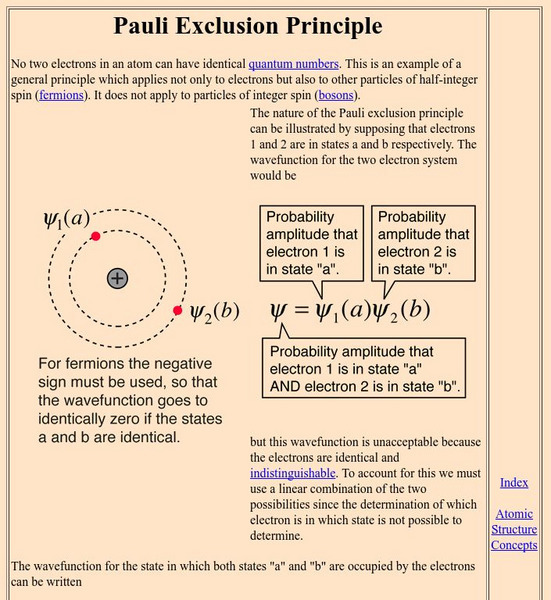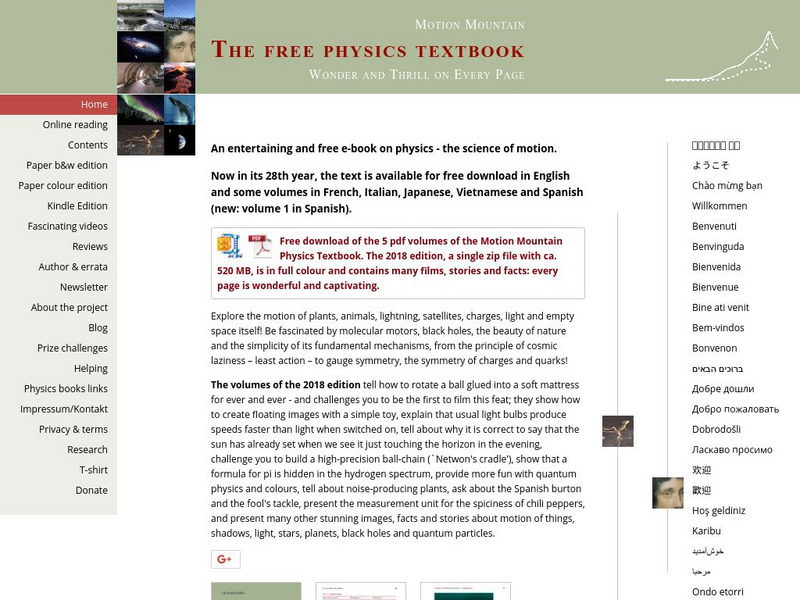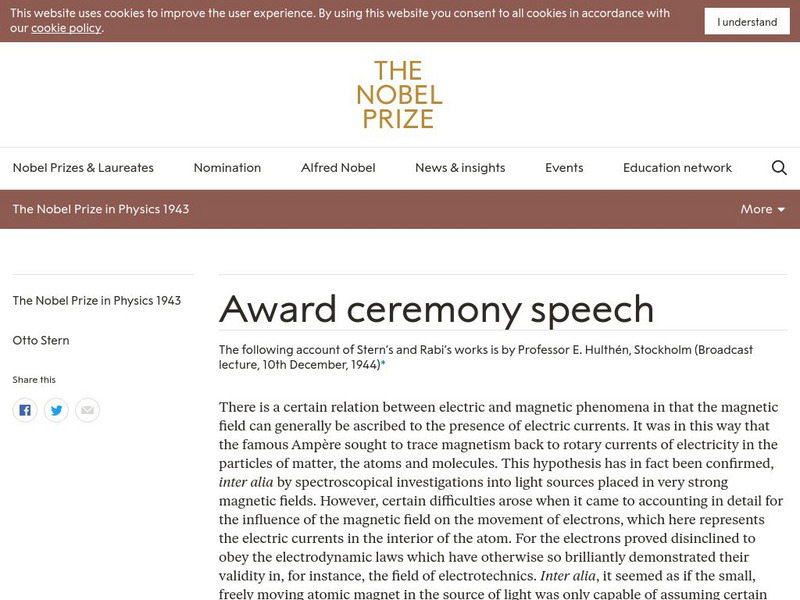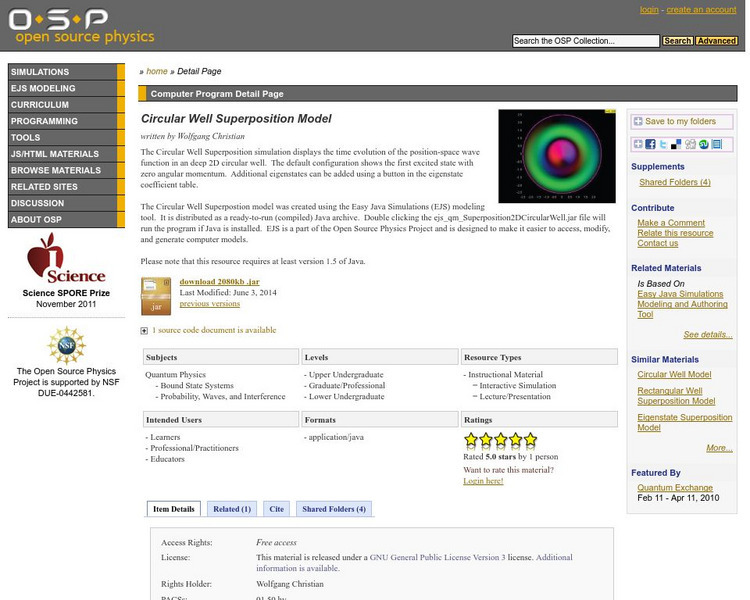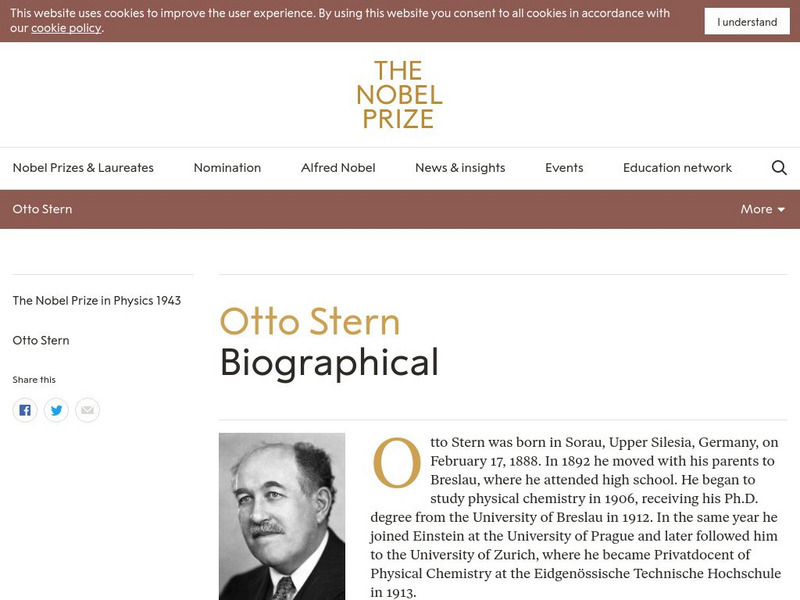Hi, what do you want to do?
Georgia State University
Georgia State University: Hyper Physics: Pauli Exclusion Principle
An explanation of the Pauli Exclusion Principle in mathematical terms.
University of Colorado
University of Colorado: Physics 2000: Schrodinger's Atom
A simple dialogue to explain quantum theory and the Schrodinger equation. Includes several java applets.
University of Colorado
University of Colorado: Physics 2000: The Pauli Exclusion Principle
This site from the University of Colorado at Boulder has great information on the Pauli Exclusion Principle. Pictures are provided along with links to additional information. The information provided is not in-depth and it is...
Nobel Media AB
The Nobel Prize: Niels Bohr Biographical
The Nobel Foundation provides this site about Niels Bohr's contributions to the world of physics, specifically his "investigation of the structure of atoms and of the radiation emanating from them." This biography includes information on...
National High Magnetic Field Laboratory
Magnet Academy: Paul Dirac
Paul Adrien Maurice Dirac was an outstanding twentieth century theoretical physicist whose work was fundamental to the development of quantum mechanics and quantum electrodynamics. He was awarded the Nobel Prize for Physics jointly with...
Other
Motion Mountain Physikverein: Motion Mountain
A free PDF introductory physics textbook with color images, videos, and animations. The textbook aims to show how physics explains the natural world. The book is broken into kinematics, relativity, light, quantum mechanics, and The...
National High Magnetic Field Laboratory
Magnet Academy: Timeline of Electricity and Magnetism: 1900 1909
Albert Einstein publishes his special theory of relativity and his theory on the quantum nature of light, which he identified as both a particle and a wave. With ever new appliances, electricity begins to transform everyday life.
University of Maryland
University of Maryland: Optics, Electromagnetic Waves
This site from the University of Maryland provides part of an anecdotal history of optics and the study of light. Extremely thorough treatment of how scientists came to believe in the wave nature of light, the idea of an electromagnetic...
University of Colorado
University of Colorado: Physics 2000: Quantum Atom: Angular Momentum of an Electron
A very technical explanation of the angular momentum of an electron.
Nobel Media AB
The Nobel Prize: Nobel Prize in Physics 1943 Award Ceremony Speech
At this site read Professor E. Hulthen's "account of Stern's and Rabi's works," and contributions to the study of molecular rays.
CK-12 Foundation
Ck 12: The Bohr and Quantum Models of the Atom
[Free Registration/Login may be required to access all resource tools.] Students explore how the study of the hydrogen emission spectrum led to the Bohr model of the atom, in which electrons exist in states of constant energy.
CK-12 Foundation
Ck 12: Physics Simulation: Atomic Colors
[Free Registration/Login Required] Explore the Bohr model of atoms by studying the absorption and emission of light from simple gases in the context of starlight using this interactive simulation. A PDF worksheet and a video tutorial are...
American Association of Physics Teachers
Com Padre Digital Library: Open Source Physics: Circular Well Superposition
A simulation that displays the time evolution of the position-space wave function using the Circular Well Eigenstate Superposition model.
Other
Einstein Archives Online
Online access to portions of Einstein's original papers and manuscripts.
Other
Historical Society of Princeton: Einstein in Princeton
Biography of Albert Einstein from an exhibit at Princeton University.
Georgia State University
Georgia State University: Hyper Physics: Hund's Rules
A complete overview of Hund's rules including exceptions.
Georgia State University
Georgia State University: Hyper Physics: Relativistic Energy
A mathematically understandable presentation of relativistic energy. Parts include Relativistic Energy, Rest Mass Energy, Conservation of Energy, Pair Production, Relativistic Kinetic Energy, and even Kinetic Energy. A couple of...
Michigan State University
Michigan State University: Elementary Physics Ii: The Pauli Exclusion Principle
The Pauli Exclusion Principle requires that all electrons in an atom have unique energy levels.
Georgia State University
Georgia State University: Hyper Physics: Photoelectric Effect
Using graphics, words and numbers, the photoelectric effect is described and explained. Planck's theory about quanta of light is explained. Photon energies for the various regions of the EM spectrum are listed. An interactive JavaScript...
National High Magnetic Field Laboratory
Magnet Academy: Richard Feynman
Theoretical physicist Richard Phillips Feynman greatly simplified the way in which the interactions of particles could be described through his introduction of the diagrams that now bear his name (Feynman diagrams) and was a co-recipient...
Nobel Media AB
The Nobel Prize: Bose Einstein Condensation in Alkali Gas [Pdf]
This 14-page document contains advanced information about Bose-Einstein condensation, providing historical background for the topic and explaining how BEC was demonstrated in 1995 by research laboratories. Requires ."pdf," software to...
PBS
Pbs: People & Discoveries: Ernest Rutherford
A lovely biographical piece about Ernest Rutherford. A number of personal notes, along with extensive information about the physics work he did. Nice quote at the end.
Nobel Media AB
The Nobel Prize: Otto Stern Biographical
This is a brief biography on the life and scientific work of Otto Stern, a physicist honored with the Nobel Prize in physics for his "development of the molecular ray method and his discovery of the magnetic moment of the proton."
CK-12 Foundation
Ck 12: Weak Nuclear Force and the Standard Model
[Free Registration/Login may be required to access all resource tools.] Describes the development of the model of particle physics called the Standard Model.





